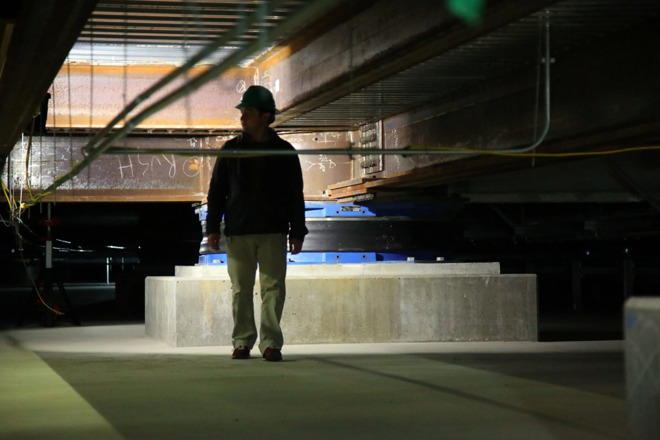The Apple Park 'spaceship' uses 692 steel saucers to protect against earthquakes
The main ring at Apple Park is one of the few buildings in the entire U.S. to use base isolation against earthquakes -- meaning that it should survive all but the biggest California tremors.

Image Credit: Jim Wilson/New York Times
The isolation system consists of 692 large, stainless-steel saucers located two stories underground, the New York Times revealed on Tuesday. Should a quake strike, the saucers can shift as far as 4 feet in any given direction.
Selected by Apple co-founder Steve Jobs and design Jony Ive, the system is modeled after similar ones in Japan. Japan has about 9,000 buildings with some version of base isolation, since the country is regularly rocked by quakes that can cause massive death and destruction. The 2011 Tohoku earthquake, coinciding with the launch of the iPad 2 on March 11, killed some 15,897 people and triggered the Fukushima Daiichi nuclear disaster.
Jobs was inspired by Japanese engineering, Ive told the Times. In fact Ive has reportedly spent four years renovating his own San Fransisco home to protect against quakes, which may make it more resilient than some of the city's skyscrapers.
Apple is one of the few Silicon Valley businesses to have any kind of earthquake-proofing, warned structural engineer Evan Reis.
"A lot of Silicon Valley companies, whether they are startups or established companies, are in buildings from the 1970s and 1980s that don't meet current code requirements," he said. Construction of Apple Park began in November 2013.
Much of California runs along the San Andreas Fault, and San Francisco Bay Area is especially vulnerable, having not one but seven major fault lines. Were the Bay to see a repeat of the infamous 7.8 quake in 1906 it would have catastrophic human and economic effects, given that the combined San Jose, San Francisco, and Oakland area has swollen to over 8.8 million people -- many of them forming the core of multinational tech giants like Apple, Google, and Facebook. The collapse of Apple Park alone would potentially kill thousands of people, including executives like Ive and CEO Tim Cook.

Image Credit: Jim Wilson/New York Times
The isolation system consists of 692 large, stainless-steel saucers located two stories underground, the New York Times revealed on Tuesday. Should a quake strike, the saucers can shift as far as 4 feet in any given direction.
Selected by Apple co-founder Steve Jobs and design Jony Ive, the system is modeled after similar ones in Japan. Japan has about 9,000 buildings with some version of base isolation, since the country is regularly rocked by quakes that can cause massive death and destruction. The 2011 Tohoku earthquake, coinciding with the launch of the iPad 2 on March 11, killed some 15,897 people and triggered the Fukushima Daiichi nuclear disaster.
Jobs was inspired by Japanese engineering, Ive told the Times. In fact Ive has reportedly spent four years renovating his own San Fransisco home to protect against quakes, which may make it more resilient than some of the city's skyscrapers.
Apple is one of the few Silicon Valley businesses to have any kind of earthquake-proofing, warned structural engineer Evan Reis.
"A lot of Silicon Valley companies, whether they are startups or established companies, are in buildings from the 1970s and 1980s that don't meet current code requirements," he said. Construction of Apple Park began in November 2013.
Much of California runs along the San Andreas Fault, and San Francisco Bay Area is especially vulnerable, having not one but seven major fault lines. Were the Bay to see a repeat of the infamous 7.8 quake in 1906 it would have catastrophic human and economic effects, given that the combined San Jose, San Francisco, and Oakland area has swollen to over 8.8 million people -- many of them forming the core of multinational tech giants like Apple, Google, and Facebook. The collapse of Apple Park alone would potentially kill thousands of people, including executives like Ive and CEO Tim Cook.

Comments
https://www.salk.edu/about/history-of-salk/
And as far as California, well not everybody can afford that and tax structure and infrastructure quality may explain a bit status of things in that state.
"Evidence for a link between fracking and earthquakes is incomplete, but in more than one area where fracking has been practiced, a noted increase in earthquakes has been recorded. In Arkansas in the United States, for instance, two injection wells, which are wells used to inject liquids into rock layers as part of the fracking process had operations suspended in early 2011, pending further study, after more than 800 small earthquakes, one registering 4.8 on the Richter scale were recorded in the area around the wells.
A similar occurrence near a fracking operation in Great Britain in 2011 also caused a halt in an operation, pending further study. The increase in earthquakes, most, if not all, of which are classified as microquakes, or very slight tremors, in areas where fracking operations are undertaken is well documented. The mechanism by which fracking might cause these quakes is not understood nor has it been conclusively proven that such a direct link between fracking and earthquakes exists."
Normally this would be meant as a lighthearted observation/comment, but after yesterday’s WWDC with several Rush mentions (Fly By Night album cover and “Rush?” written on the screen and actually mentioned) ... makes one wonder.
Glad to see Rush getting the respect they deserve from brilliant minds that think different.